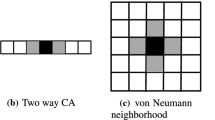Abstract
The paper mentioned in the title used an incorrect implementation of the algorithms to produce the experimental results. The mistake significantly impacts the computational efficiency of the algorithms, on which they are evaluated. In this correction we explain the mistake, present the new results, and update our conclusions based on the new results.
Similar content being viewed by others
Avoid common mistakes on your manuscript.
This is a correction to Thuijsman and Reniers (2022).
In a continuation on Thuijsman and Reniers (2022), it was pointed out by an anonymous reviewer that our implementation used for the experiments contained a mistake. We are very grateful to this reviewer for pointing out this mistake. We realized that the implementation of Thuijsman and Reniers (2022) contained the same mistake.
Although the algorithms were still functionally correct, because of the mistake their computational efficiency was significantly worse than that of a proper implementation. Since Thuijsman and Reniers (2022) aims to improve computational efficiency, and uses experiments to indicate that improvement, the implementation should be properly efficient. Note that the theoretical parts of Thuijsman and Reniers (2022) are still correct, the mistake only affects the timing measurements in the experimental part of the paper.
However, because the mistake has a significant impact on the timing measurements, we present this correction. In this correction we explain the mistake, present the new results, and update our conclusions based on the new results.
In particular, the reachability search algorithms (Algorithms 3 and 4 in Thuijsman and Reniers (2022)) were not properly implemented. This is because an inappropriate data structure was used to store the transition relation. In the erroneous implementation, an edge list structure was used: a list of triples, each specifying an origin state, event, and target state. Using an edge list, each time the neighbors of some state are evaluated (e.g., lines 6-7 in Algorithm 3 of Thuijsman and Reniers (2022)), an iteration is performed over all transitions, leading to a complexity of \(O(|X|\cdot |\longrightarrow |)\) for the algorithm overall. Instead, the transition relation should be stored using an adjacency list: each index in the list corresponds to a state index and stores all neighbors of that state. When an adjacency list is used, no iteration is required to find the neighbors of a state, and a complexity of \(O(|X|+|\longrightarrow |)\) for the reachability search can be obtained (Kleinberg and Tardos , 2005).
The implementation has been corrected. The code repositoryFootnote 1 we refer to in Thuijsman and Reniers (2022) has been updated accordingly. We have repeated the experiments from Thuijsman and Reniers (2022). Tables 1, 2, and 3 respectively present the updated results relative to Tables 1, 2, and 3 in Thuijsman and Reniers (2022). Each runtime value we present in this correction is the mean runtime over 100 executions of the experiment.
We observe that in almost all experimental cases Transformational Supervisor Synthesis (TSS) requires more runtime than basic Supervisor Synthesis (SS). Perhaps in some particular cases, TSS may be quicker than SS. However, based on these updated experimental results, we must conclude that in practical cases TSS is generally less efficient than SS. Therefore, it is recommended to use SS over TSS, also for evolving systems.
Data Availability
The implementation of the algorithms and models can be found here: https://github.com/sbthuijsman/JDEDS_TSS
References
Kleinberg J, Tardos E (2005) Algorithm Design. Addison-Wesley Longman Publishing Co., Inc, USA
Thuijsman SB, Reniers MA (2022) Transformational supervisor synthesis for evolving systems. Discrete Event Dynamic Syst 32(2):317–358. https://doi.org/10.1007/s10626-021-00354-0
Author information
Authors and Affiliations
Corresponding authors
Additional information
Publisher's Note
Springer Nature remains neutral with regard to jurisdictional claims in published maps and institutional affiliations.
Rights and permissions
Open Access This article is licensed under a Creative Commons Attribution 4.0 International License, which permits use, sharing, adaptation, distribution and reproduction in any medium or format, as long as you give appropriate credit to the original author(s) and the source, provide a link to the Creative Commons licence, and indicate if changes were made. The images or other third party material in this article are included in the article’s Creative Commons licence, unless indicated otherwise in a credit line to the material. If material is not included in the article’s Creative Commons licence and your intended use is not permitted by statutory regulation or exceeds the permitted use, you will need to obtain permission directly from the copyright holder. To view a copy of this licence, visit http://creativecommons.org/licenses/by/4.0/.
About this article
Cite this article
Thuijsman, S., Reniers, M. Correction to: Transformational supervisor synthesis for evolving systems. Discrete Event Dyn Syst 33, 509–513 (2023). https://doi.org/10.1007/s10626-023-00384-w
Received:
Accepted:
Published:
Issue Date:
DOI: https://doi.org/10.1007/s10626-023-00384-w




